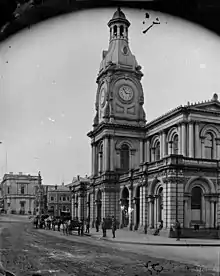Colonial Bank of New Zealand
Colonial Bank of New Zealand was a trading bank run from Dunedin, New Zealand which operated independently for more than twenty years. A public company listed on the local stock exchanges it was owned and controlled by New Zealand entrepreneurs and not London or Australian bankers. Still subject to the same vicissitudes as its fellow colonial banks it was bought by the Bank of New Zealand in 1895.
| Type | public listed company |
|---|---|
| Industry | Banking |
| Founded | July 1874 |
| Defunct | 1898 |
| Headquarters | Dunedin, New Zealand |
Key people |
|
| Products | Banking, financial and saving services |

It is remembered in the 21st century because its final collapse brought about the suicide of M.P. William Larnach who had been one of its founders.
Inception
Colonial Bank of New Zealand was established in Dunedin, New Zealand in April 1874 as a public listed company.[2][3] Dunedin with its involvements with the South Island's gold mining was the major source of local capital for New Zealand's entrepreneurs.
The Bank of New Zealand had been founded in October 1861 by a similar local group in Auckland and, to pull capital north, it had opened a branch in Dunedin in December 1861. The Colonial Bank of New Zealand may have been formed just to re-capture the Bank of New Zealand's South Island business.[4]
The Colonial Bank had expanded to 27 branches and an office in London by 1889. Trading banks got into difficulties in both Australian and New Zealand at the end of the 1880s.[5][6]
There was a major financial slump in 1893 and negotiations began to amalgamate the Colonial Bank with the Bank of New Zealand. In 1895 the Bank of New Zealand took it over[7] then, finding itself in major difficulties, the Bank of New Zealand was obliged to let the Colonial Bank collapse in 1898.
W. J. M. Larnach, M.P. who had been one of the promoters[2] and owned a substantial shareholding bought more shares just prior to the collapse to show his confidence in its survival. Learning of the collapse he shut himself in one of parliament's committee rooms and shot himself dead.[8]
The business was liquidated by 1901 and the company dissolved in 1905.[9]
New Zealand's banks
Together the Bank of New Zealand and the Colonial Bank were New Zealand's only significant local banks.
At that time New Zealand's overseas-owned banks were: National Bank of New Zealand (now ANZ), Bank of New South Wales (Westpac), Union Bank of Australia and the Bank of Australasia (ANZ).

 Oamaru branch building, Thames Street circa 1880 |
References
- The Colonial Bank Otago Daily Times 1 October 1874 Page 3
- "A New Bank". Otago Daily Times. 27 April 1874. Retrieved 27 August 2020 – via Papers Past.
- "The Otago Daily Times". Otago Daily Times. 20 July 1874. Retrieved 27 August 2020 – via Papers Past.
- "History of Banking Operations in New Zealand". Manawatu Standard. 14 March 1944. Retrieved 27 August 2020 – via Papers Past.
- "New Zealand in the world economy, 19th century".
- "Finance, transport and ownership, 19th and 20th centuries".
- The Liquidation of the Colonial Bank Otago Daily Times 28 December 1895 Page 6
- Otago Daily Times 13 October 1898, Page 6
- Otago Daily Times 3 May 1905, Page 3